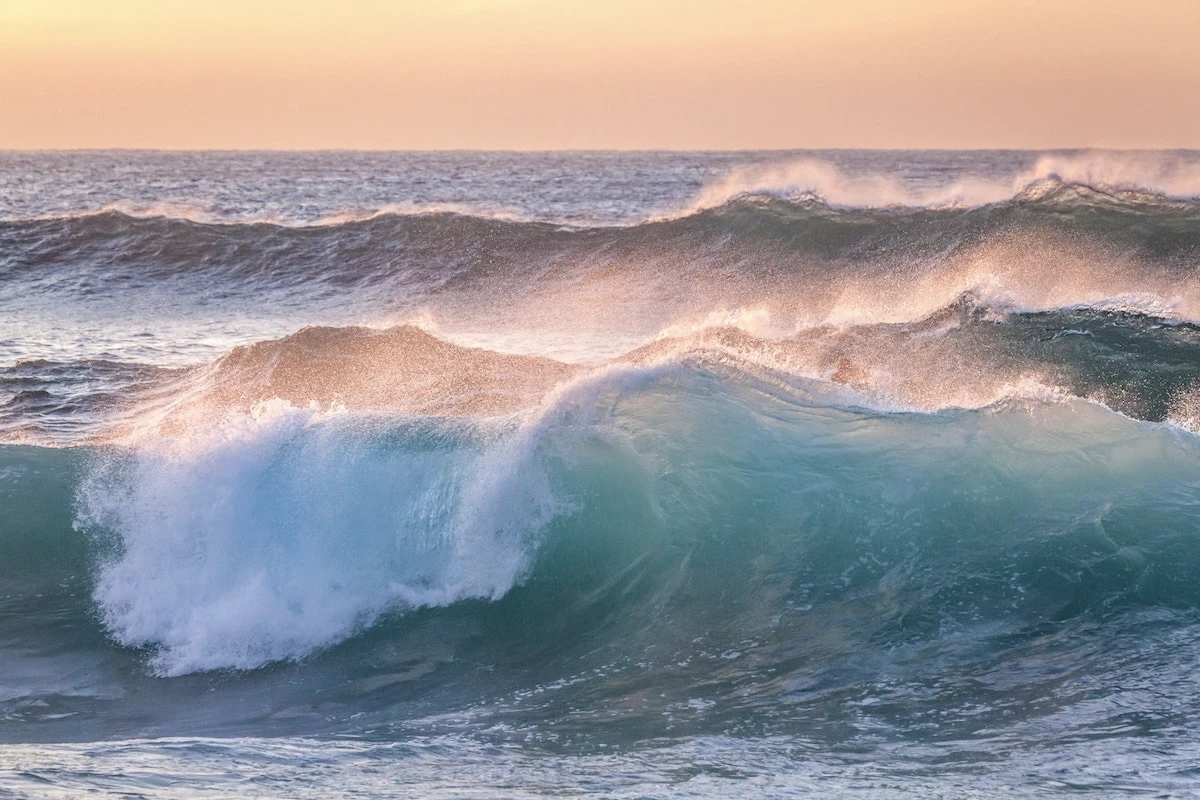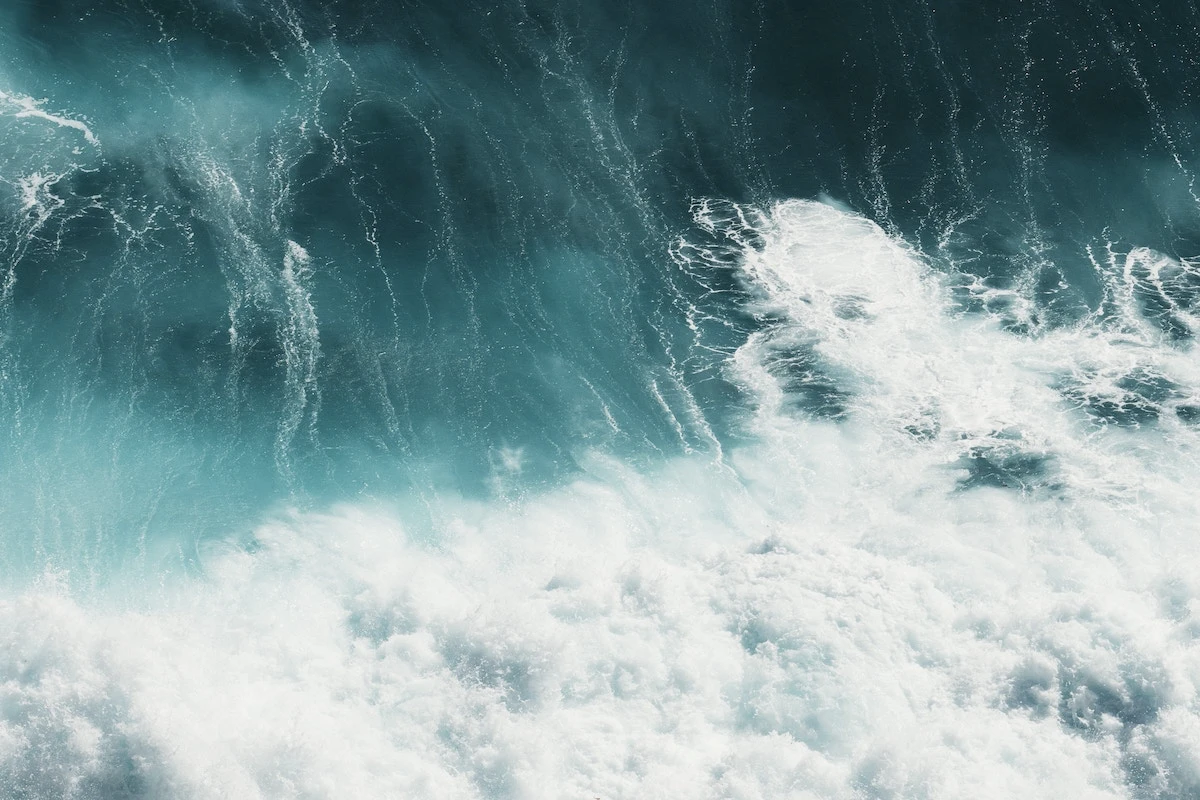Marine Energy Technologies
Nicholas May-Varas, Fellow
July 2023

Introduction
The ocean covers more than 70% of the earth’s surface and contains an enormous amount of energy. Both tidal flows and waves can be used to produce renewable electricity, with enough sites available to theoretically meet all of the world’s current electricity demand. Wave energy’s power density (the amount of electricity that can be generated from a given area) is more than four times that of solar and wind energy. Marine energy converters are also much less visually intrusive than offshore wind turbines. However, despite its immense potential, the operational capacity of wave energy currently stands at less than 13 MW. In contrast, solar and wind energy provide over 150,000 MW of electricity generation. To further put it in perspective, the amount of solar energy deployed back in 1996 surpasses today’s combined capacity of wave and tidal power.
Solar and wind power grew rapidly over the last three decades driven initially by government incentives, but also because of rapid innovation and economies of scale driving down cost. Ocean power could be starting down a similar path.
A variety of innovators have made fast progress towards commercializing marine energy technologies attracting more than $950M in investments. Access to testing facilities has been a bottleneck in the past, but the US DOE recently awarded $25M for eight projects that will test at PacWave (a new wave energy test facility being developed off the Oregon Coast). Momentum is building and many experts now predict gigawatts of capacity to be deployed by 2030.
This paper will take a closer look at marine energy technologies, including the opportunities and challenges associated with the marine energy industry, how the technologies can complement solar and wind energy, and what to consider when investing in a marine energy company.
Marine Energy Technologies Are Improving
There are two major types of marine energy being pursued today: tidal and wave. Tidal generation is more mature and simpler from an engineering perspective, but potential sites to deploy wave energy are more abundant.
The most commonly developed tidal turbine is called a horizontal-axis tidal turbine. Orbital Marine Power and Verdant Power are two tidal energy companies currently developing such technology, but their mounting systems differ. Orbital Marine Power’s turbines are attached to a moored floating platform, whereas Verdant Power’s turbines are mounted to the floor of a body of water. One of Orbital Marine Power’s tidal turbines is a multi-MW scale system and has been operating in Orkney since 2021.

The best tidal locations are where you have a large bay and the generator can be placed at the mouth. This limits the number of high quality deployment locations. Wave energy can be deployed in most coastal areas, however some locations (such as off the coast of the Pacific Northwest) have more available energy. In the United States, the available wave energy is more than six times that of tidal energy. However, converting the oscillating motion of waves into a smooth power output can be challenging.
The most commonly developed wave energy converter (WEC) is called a point absorber WEC. CalWave, Oscilla Power, and CorPower are wave energy companies currently developing such technology. CalWave’s xWaveTM Series WEC generates electricity from the relative motion between a float submerged below the ocean’s surface and the ocean floor. Oscilla Power’s Triton-C WEC operates similarly, however its float is only partially submerged and reacts against a ring-shaped reaction structure to generate electricity. Most designs primarily use vertical motion to produce power, but Wavepiston’s WEC is an alternative design that captures the horizontal motion of waves. As well as the devices mentioned, there are also many other configurations.
The goal is to develop an efficient device that can operate in a variety of wave conditions (e.g. various wave heights and frequencies), while still outputting smooth power. Power take-off (PTO) systems are a component of WECs that are used to convert wave energy into electricity. Some systems have a direct-drive mechanical connection to the generator while others force hydraulic fluid or air through a turbine powered generator. Hydraulic reservoirs, power electronics, and ultracapacitors can be used to smooth the output across waves.
As well as producing a smooth power output, WECs must be able to function in harsh ocean conditions, such as extreme waves that can be over 30 feet tall. Wave height and wave period values can vary significantly, which companies must consider when they are designing their technologies. In the PacWave region, wave height and wave period values can range from about 0-32 feet and 5-19 seconds, respectively. Extreme waves are a major design challenge because they can damage devices and add cost for reinforcing structures. Calwave and Oscilla Power overcame this challenge by designing their respective WECs to submerge below a certain depth in order to reduce damage. CorPower developed a phase control technology that can detune the buoy in extreme waves. Wavepiston has flaps that are designed to release and provide a bypass for larger waves if the force is too great. A hull’s material (which is commonly made of either steel or concrete) is another important consideration. For example, even though steel is a very strong material, steel can be 10 times more expensive per kilogram than reinforced concrete.
In all of these systems there are tradeoffs for cost and complexity while improving efficiency and allowing operation across a wider range of conditions. Routine planned maintenance is much more challenging while operating at sea and needing to work within favorable weather windows. In order to demonstrate and improve reliability, companies are conducting tests before deploying full-scale devices in the ocean. For example, CorPower designed and built a dry test facility (rated at 7.2 MW) to test the robustness and reliability of their systems. They also operated a half-scale prototype for six months off the coast of Portugal. Finding a site, permitting, and setting up testing infrastructure, like power transmission back to the shore, can be a major challenge well outside the skillset of an early-stage startup. Luckily there are an increasing number of supportive wave energy test sites around the world.
Diversified Renewables
Perhaps the most exciting benefit of marine energy is its potential to complement intermittent power from solar and wind. As the sun sets each day and air slows down, waves continue to move. With the rapid installation of solar and wind energy technologies, the grid is struggling more to deal with intermittency. Waves are more predictable than solar and wind, and individual devices that use marine energy have, on average, a larger capacity factor (the ratio of produced to potential electrical power production). WEC capacity factors are typically 25-35% vs. ~18% for utility-scale PV systems. This will become even more important as the share of intermittent renewables like solar and wind continues to increase. Co-locating wave and offshore wind technologies could decrease power intermittency (and could also decrease the amount of transmission infrastructure). In this way, marine energy can be considered as a competitor to battery energy storage rather than solar and wind. As of 2019, the levelized cost of storage of large-scale battery storage (400 MWh of capacity) ranged from about $0.2/kWh to about $0.39/kWh.
Reducing Cost and Scaling Up
Both wave and tidal technologies are too expensive today for widespread adoption. The current average levelized cost of electricity (LCOE) values are about $0.43/kWh and $0.33/kWh, respectively, while solar and wind LCOE values can range from about $0.05/kWh to $0.10/kWh. The LCOE values for coal and gas combined cycle can range from about $0.068/kWh to $0.166/kWh and about $0.039/kWh to $0.101/kWh, respectively. However, with incentives like the Renewable Electricity Production Tax Credit and the Business Energy Investment Tax Credit, many are predicting that these technologies can gain traction and begin moving down the cost curve. Between 2010 and 2021, the cost of utility-scale PV projects and onshore wind decreased by 88% and 68%, respectively, in this same way, driven by early incentives/subsidies (such as the Energy Policy Act of 2005 and the Investment Tax Credit). Two pieces of legislation that can increase the rate of technology development are the Inflation Reduction Act of 2022 and the Bipartisan Infrastructure Law. The Inflation Reduction Act of 2022 provides resources regarding climate and energy, and a part of the act allocates federal tax credits for hydropower and marine energy. The Bipartisan Infrastructure Law allocates over $70 million for marine energy projects and centers.

Based on a report by IRENA, there are almost 3 GW of wave and tidal projects in the pipeline, and by 2030, there could be 10 GW of commercially deployed projects and the LCOE could decrease below $0.15/kWh. Detailed bottom-up techno-economic models developed by the WEC companies themselves generally line up with these projections and have identified specific opportunities for cost reduction through some combination of economies of scale and continued design improvements. Island communities could be good early customers because they have limited land area and some communities often pay over $0.30/kWh for electricity mainly generated from oil (which is easier to transport and burn, but more expensive than natural gas and coal). Companies working in the Blue Economy (a nascent industry related to sustainably using ocean resources) could also benefit from using marine energy technologies. For example, marine energy technologies could power underwater autonomous vehicles that monitor ocean ecosystem health.
Investing in Marine Energy
There are over 25 tidal stream energy companies and more than 30 wave energy companies with a Technology Readiness Level (TRL) greater than 6. The list shown below provides a summary of this landscape. Most of the companies mentioned in the list have tested some of their technology in the open ocean, which is a crucial step in the development process.
Information regarding various marine energy companies
Used publicly available data that may change and/or may not be up-to-date
Tidal
Minesto
Device Type: Tidal/current kite
Current or Potential Rated Power: 100 kW to 1.2 MW
Headquarters: Sweden
Orbital Marine Power
Device Type: Horizontal-axis turbine
Current or Potential Rated Power: MW-scale
Headquarters: Scotland
SIMEC Atlantis Energy
Device Type: Horizontal-axis turbine
Current or Potential Rated Power: MW-scale
Headquarters: United Kingdom
Verdant Power
Device Type: Horizontal-axis turbine
Current or Potential Rated Power: 35 kW
Headquarters: United States
Wave
AW Energy
Device Type: Oscillating wave surge WEC
Current or Potential Rated Power: 125 kW to 1,200 kW
Headquarters: Finland
AWS Ocean Energy
Device Type: Point absorber WEC
Current or Potential Rated Power: kW-scale
Headquarters: United Kingdom
C-Power
Device Type: Point absorber WEC
Current or Potential Rated Power: Small-scale to utility-scale
Headquarters: United States
CalWave
Device Type: Point absorber WEC
Current or Potential Rated Power: MW-scale
Headquarters: United States
Carnegie Clean Energy
Device Type: Point absorber WEC
Current or Potential Rated Power: Small-scale to utility-scale
Headquarters: Australia
CorPower Ocean
Device Type: Point absorber WEC
Current or Potential Rated Power: 300 kW
Headquarters: Sweden
Eco Wave Power
Device Type: Point absorber WEC
Current or Potential Rated Power: kW-scale to MW-scale
Headquarters: Sweden
Hace
Device Type: Oscillating water column WEC
Current or Potential Rated Power: Small-scale to utility-scale
Headquarters: France
Havkraft
Device Type: Oscillating water column WEC
Current or Potential Rated Power: kW-scale
Headquarters: Norway
OceanEnergy
Device Type: Oscillating water column WEC
Current or Potential Rated Power: kW-scale to MW-scale
Headquarters: Ireland
Ocean Power Technologies
Device Type: Point absorber WEC
Current or Potential Rated Power: kW-scale
Headquarters: United States
Oscilla Power
Device Type: Point absorber WEC
Current or Potential Rated Power: 50 W to 1 MW
Headquarters: United States
Resen Waves
Device Type: Point absorber WEC
Current or Potential Rated Power: 300 W
Headquarters: Denmark
Sigma Energy
Device Type: Point absorber WEC
Current or Potential Rated Power: kW-scale
Headquarters: Slovenia
Wave Swell Energy
Device Type: Oscillating water column WEC
Current or Potential Rated Power: kW-scale
Headquarters: Australia
Wello
Device Type: Rotating mass WEC
Current or Potential Rated Power: 0.5-1 MW
Headquarters: Finland
Weptos
Device Type: Point absorber WEC
Current or Potential Rated Power: MW-scale
Headquarters: Denmark
When considering possible marine energy investment opportunities, investors should consider the full ecosystem of customers, researchers, and companies. The list shown below shows an overview of potential markets, investment firms with an interest in ocean-related technologies, universities, labs, and research centers.
Marine energy applications and resources
Sub-markets
Ocean observation
Underwater vehicle charging
Aquaculture
Seawater mining
Seawater desalination
Coastal resiliency and disaster recovery
Isolated communities
Utility companies
Investment Firms
Propellor VC
Ocean 14 Capital
S2G Ventures
Katapult Ocean
SWEN Blue Ocean
Universities
Oregon State University
University of Washington
University of Alaska Fairbanks
University of Maine
University of Rhode Island
UC Berkeley
Labs and Research Centers
National Renewable Energy Laboratory
Sandia National Laboratory
Pacific Marine Energy Center
Hawai'i National Marine Renewable Energy Center
Southeast National Marine Renewable Energy Center
Atlantic Marine Energy Center
European Marine Energy Centre

While investors are considering various companies, some key questions for them to discuss when speaking with marine energy companies are:
- How is the company testing for durability? What types of tests has the company conducted and were the tests conducted in the ocean? How long has the company tested their device for and under what conditions?
- How does the technology smooth the power output? How efficient is the device across a range of operating conditions? What are the advantages and disadvantages of their major design decisions vs others?
- Has the company developed a techno-economic model for reducing LCOE? How might the company manufacture the devices on a large scale?
- Is the company planning ahead and thinking about maintenance?
- What is the company’s initial go-to-market strategy? For example, is the company focused on working with utility companies or providing power for smaller scale applications?
- What is the status of customer and partner conversations (power purchase agreements, transmission infrastructure, service providers for installation and maintenance)?
Conclusion
Marine energy technologies, such as tidal turbines and WECs, have the potential to provide a large share of future electricity supply while reducing the need for battery energy storage. Companies are already making significant progress to successfully commercialize these technologies. Test sites, research centers, and VC firms are critical to the development of the marine energy sector. Perhaps in another decade or two these technologies will be as commonplace, reliable, and easily available as solar and wind energy. Even though the ocean is a harsh place to work, the ocean is a massive energy source that has the potential to strengthen renewable energy portfolios.
